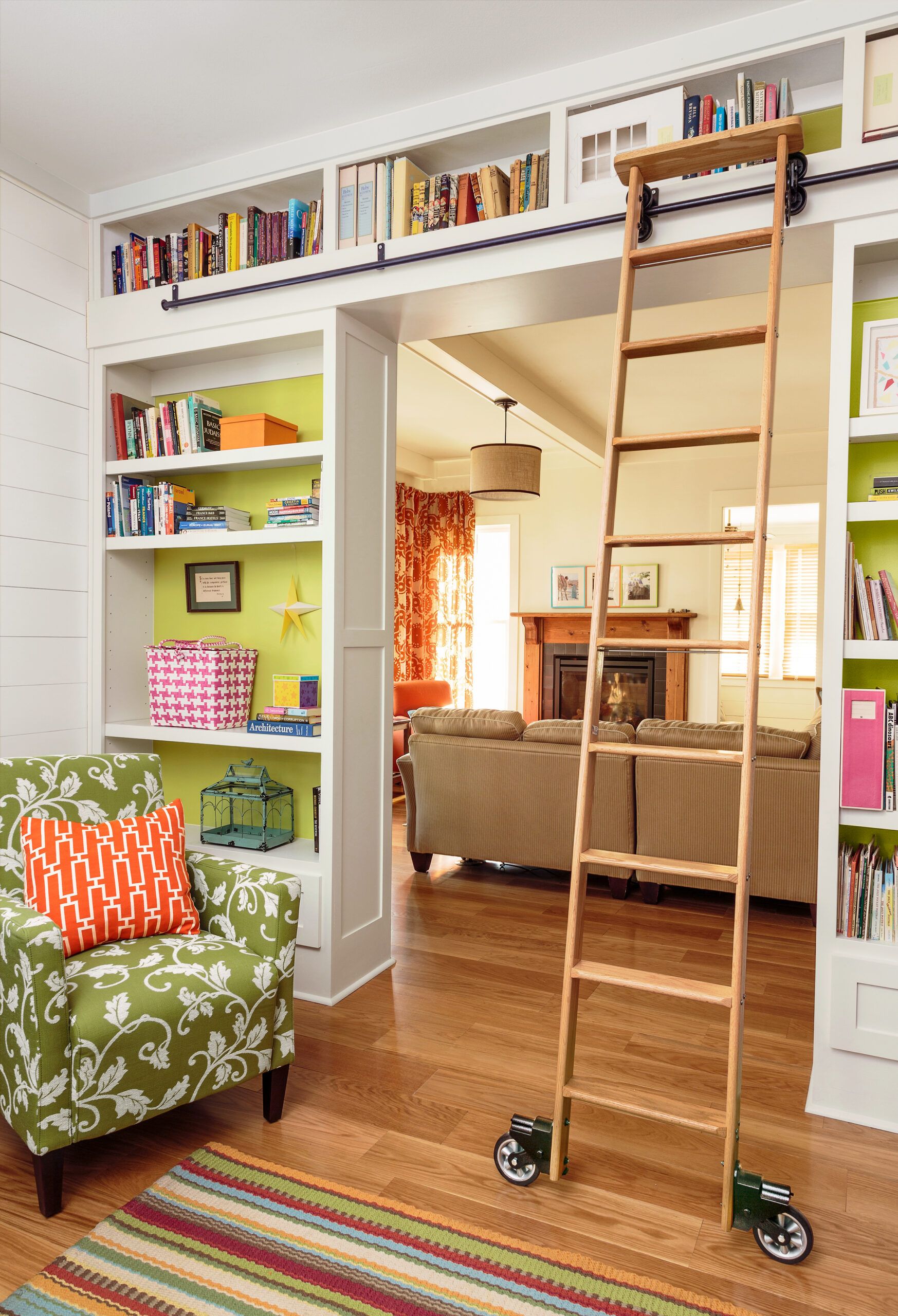Built-in bookcases offer more than just storage space. They can transform a room, adding style, charm, and architectural interest. From creating a cozy reading nook to maximizing awkward spaces, you can tailor your built-ins to suit your home’s needs and aesthetics. Let’s explore seven innovative built-in bookcase designs that will inspire you to reimagine your living spaces.
7 Styles of Built-In Bookshelves
A built-in bookcase project gives you virtually unlimited design options, but they tend to fall into one of a few categories. Here are some of the most popular.
1. Library Style
This style features bookcases arranged to form a passageway united with flat trim to create a mini library, complete with a rolling ladder that beckons young readers to hunt for a good book on the topmost shelves. Designer Bret Franks came up with the idea of building this kind of bookcase as a way to add old-house character to a new farmhouse with a completely open first floor beyond this office space.
In his project, apple-green backing keeps the built-ins fun and family-friendly, as does the mix of objects dotting the adjustable height shelves. The poplar boxes are screwed into the walls and ceiling, with flat poplar stock edging the thin ¾-inch MDF shelves for a heftier appearance and creating panel details along the bottoms and sides.
The top and bottom are wrapped with the same moldings that rim the ceiling and floor, completing the built-in look. A ladder made from a kit slides along a circular rail secured with brackets to a special facing that conceals a beefed-up support.
2. Happy Landing
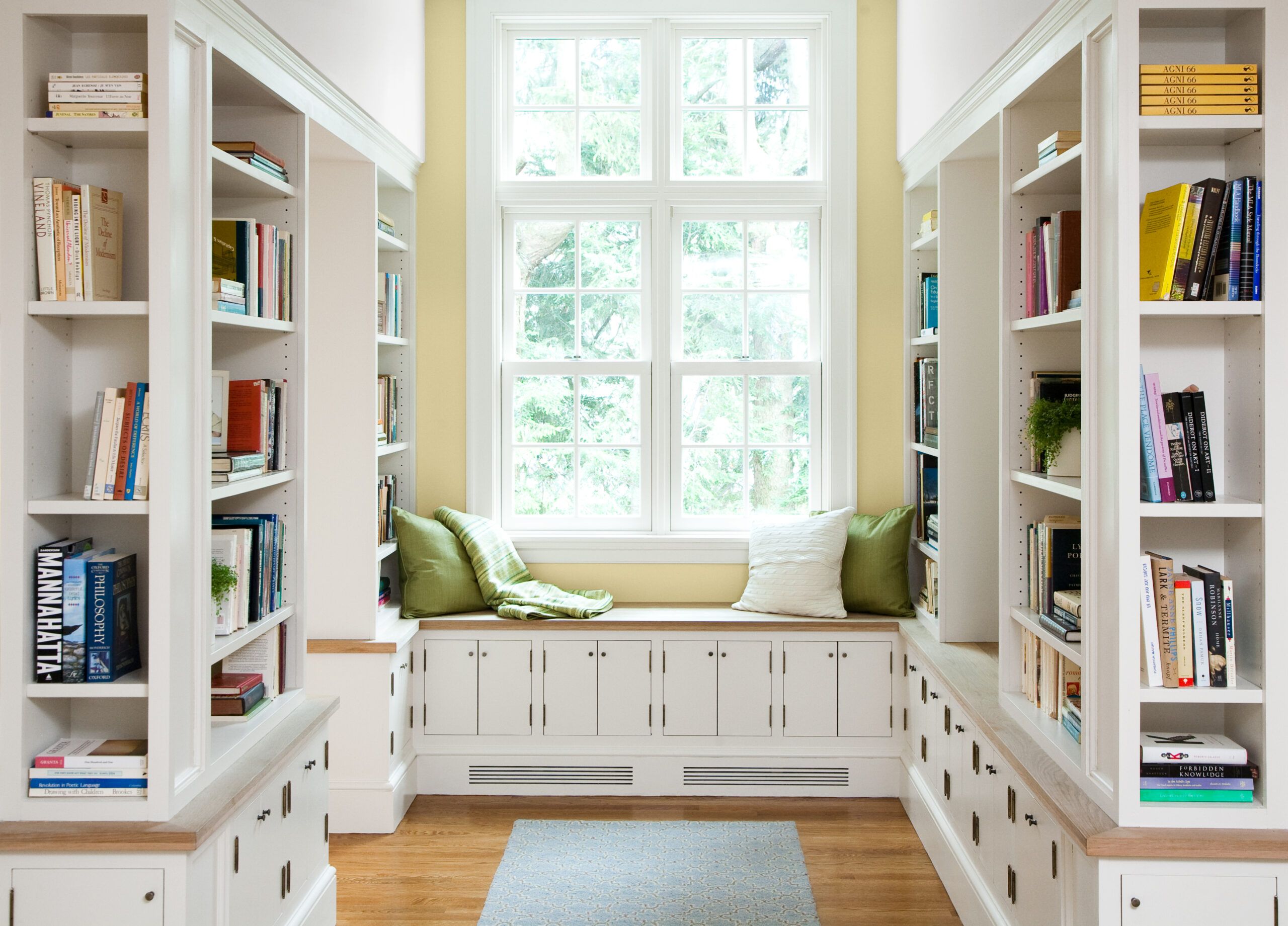
As part of the expansion of a 1915 Dutch Colonial, architect Paul Rovinelli transformed the hallway outside a new office into a light-filled reading nook. He turned two narrow shelf units outward to showcase the books since this upstairs landing is visible from the front door and added panel detail to enhance the area left beside the larger units.
Constructed from ½ clear-finish maple with MDF trim, adjustable shelves store books while window-seat cabinets hide games and other items. The large dormer window has a skylight effect, tempting readers to stay awhile.
3. Alcove Formation
Building around a furniture piece creates a cozy, architectural feel. Here, the sofa sits snugly between bookcases that form an inside corner. Crown molding can continue along the wall and connect the bookcases, as does painting the built-ins, moldings, and walls the same deep-blue hue.
Designer Ashley Whittaker extended the everything-in-its-place, shipshape feel of the room in this style with library-style case-mounted lights. Planning for such lighting ahead of building is crucial in order to safely run wiring behind the woodwork.
4. Pine-Paneled Look
Even a clean, streamlined interior needs a place to put stuff. In one example, an updated 1950s cabin took knotty pine paneling into the 21st century with a whitewash treatment and integrated shelving. The shelves in this open-plan living-dining area corral all the little things — books, art, bric-a-brac—and also maximize interior space by using the existing wall as the backing.
Designer and homeowner Bobby Houston attached the open-back shelves directly onto the horizontal pine paneling. The shelves, made from 5/4 common pine stock, are fixed in place by means of dado cuts for a slightly rustic feel, while the uniform grid of shelves keeps the look simple and spare.
5. Airy Effect
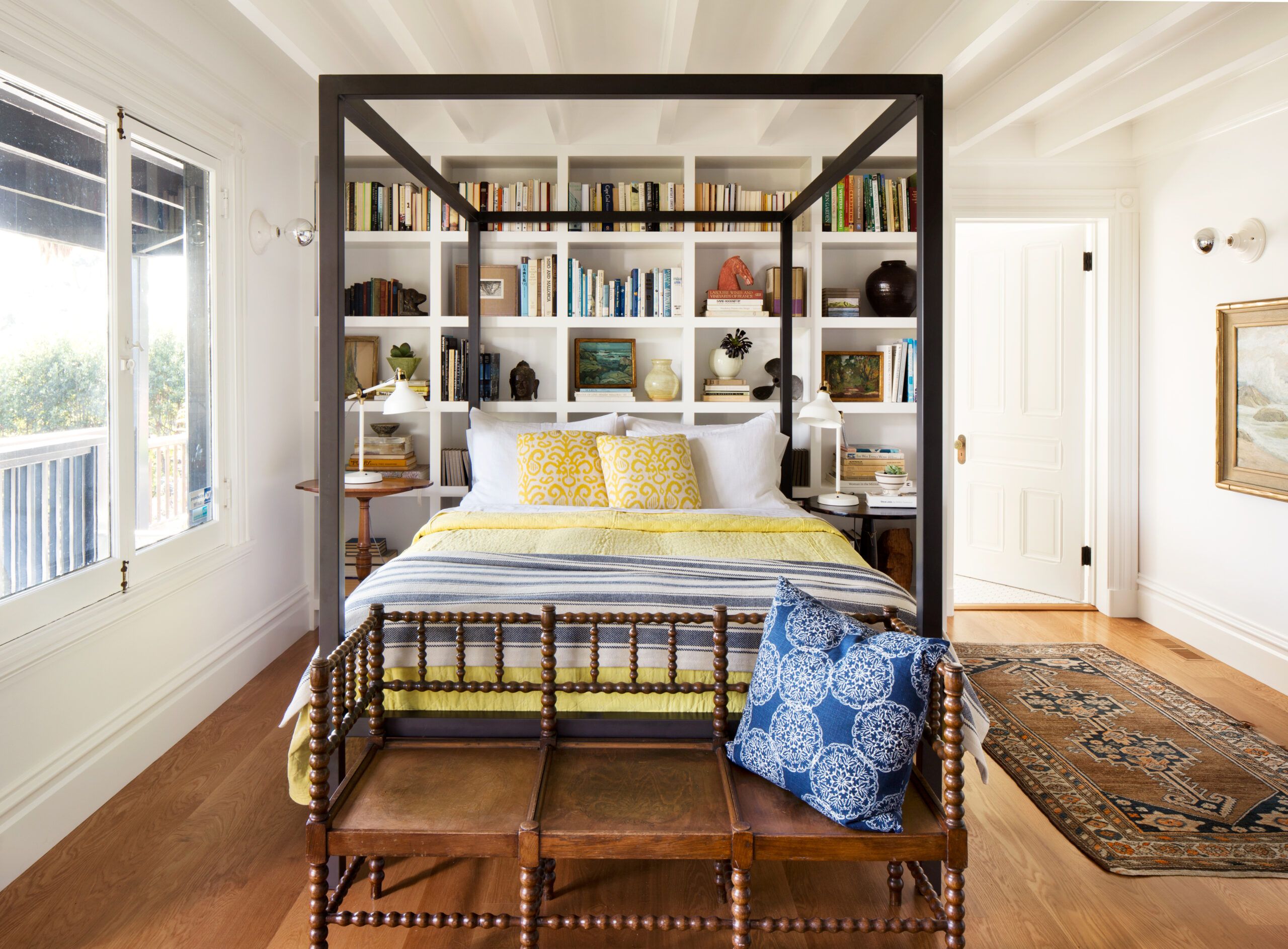
This built-in bookcase plays all the angles. Architect Mark Reilly designed the room around the minimalist canopy bed, aligning one shelf with the top of the mattress, continuing with equal-size book bays in the remaining space.
The bookcase serves as both headboard and backdrop, providing storage for extra books, reading glasses, and decorative objects. The fixed shelves mimic the rectangles formed by the bed, the bench, and even the beams overhead — creating an airiness that suggests a larger space. They also act as a sound barrier between the master bedroom and bath.
5. Curved on Top
A strategic built-in can turn an awkward niche into a design feature. In renovating a turn-of-the-century home, architect Tom Stringer had to work around some challenging existing features. Faced with a fireplace situated on a painted brick wall, he added millwork details to create depth and interest and installed an arched-top bookcase on one side to balance a low bookcase underneath a window on the other side. The built-in’s true arch — no fool-the-eye face frame here — accommodates taller collectibles and sits proud of the wall, adding an elegant shadow line.
6. Furniture Style
Plywood and trim are all it took to convert an existing recess off a back door into a furniture-like storage wall in a potting-area-cum-kitchenette serving an outdoor patio. The piece, which was built on-site, extends wall to wall and floor to ceiling, maximizing space without interfering with traffic flow.
Architect Ankie Barnes gave the simple birch-plywood shelves a French-country feel with double-bead poplar trim, simple crown molding, and, at the base, feet in front of a false toe-kick. The stepped casing around the window is a charming effect that came about out of necessity: Because of the thick masonry walls, the out-swinging casement window required a subframe as well as a jamb extension. The paint color, a modern garden green, freshens up the traditional casework.
How Deep Should Built-In Shelves Be?
The depth you choose for your built-in shelves depends on what you plan to store on them. Most shelves have a minimum depth of 11 to 12 inches, but you can customize them to fit the function you need. Here are some factors to consider:
- Book size: For standard paperbacks, 9 inches might suffice, while larger art books or textbooks may require 12 inches or more.
- Display items: Consider the depth needed for decorative objects, photo frames, or collectibles.
Storage boxes: If you plan to use storage boxes or baskets, measure their depth and add an extra inch for easy removal. - Electronics: For media centers, factor in the depth of devices like Blu-ray players or video game consoles.
Remember, deeper shelves offer more versatility but can make your room feel smaller. Strike a balance between functionality and spatial aesthetics for the best results.
What Materials Can You Use for Built-In Bookshelves?
The material you choose for your built-in bookshelves depends on what you need them to hold and the total span of the shelf. Here are some popular options:
- Solid wood: Hardwoods like oak, maple, or cherry offer strength and beauty but come at a higher cost. They’re ideal for high-end, long-lasting installations.
- Hardwood plywood: A more affordable option that still provides strength and a wide range of veneer options. It’s suitable for both painted and clear-finished shelves.
- Medium-Density Fiberboard (MDF): The most budget-friendly choice, MDF takes paint well and resists warping. However, it’s not as strong as solid wood or plywood.
- Laminate: Pre-finished and durable, laminate is a good choice for areas prone to moisture or heavy use.
- Metal: Metal shelving can be both stylish and sturdy for a modern look, though it’s less common in residential settings.
4 Types of Shelf Edge Treatments To Choose From
Built-in bookshelves often have exposed plywood ends. Here are four popular types of shelf edge treatments you can use on your built-in bookcases to cover them up while making a statement.
1. Veneer Tape
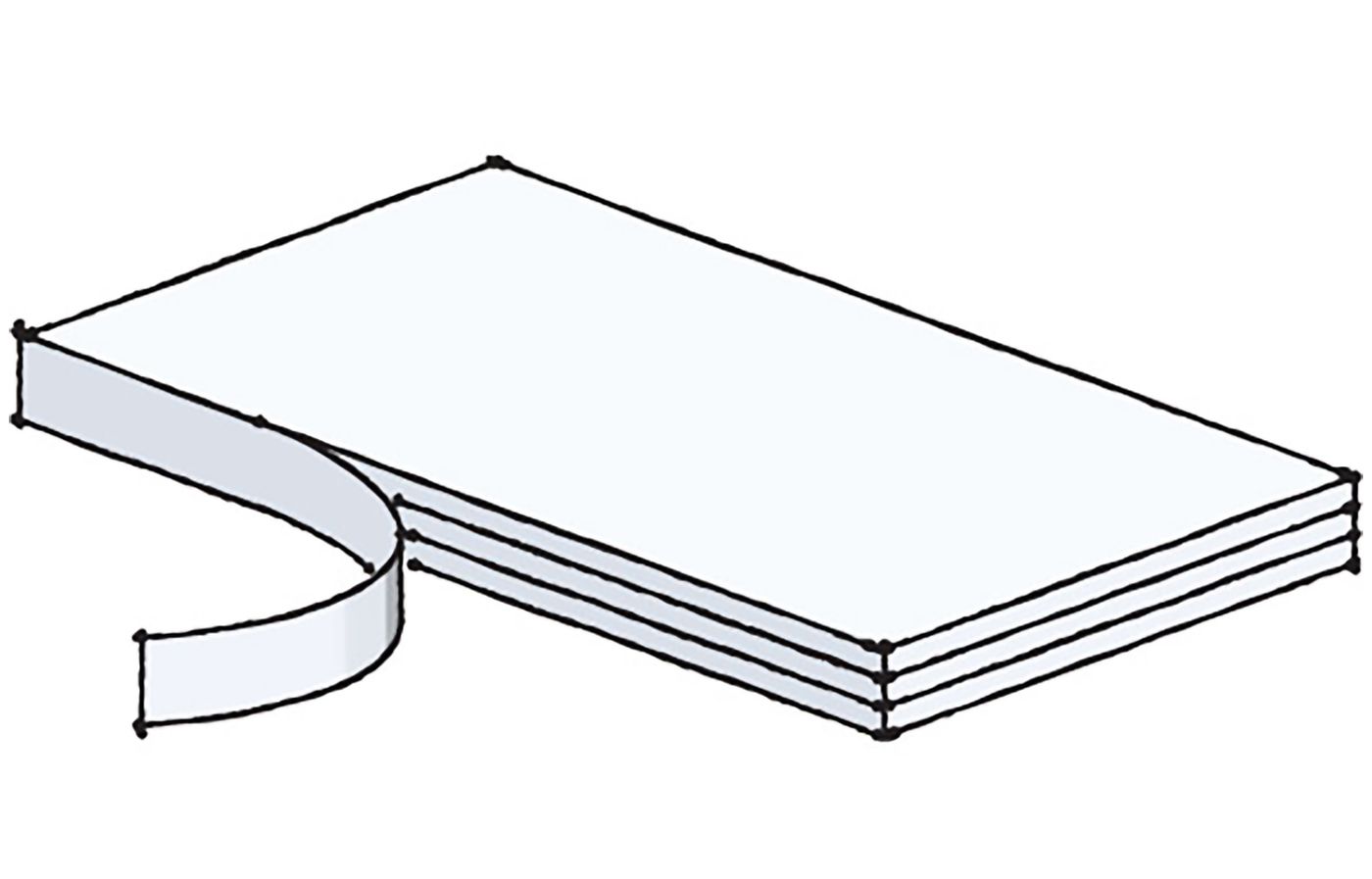
Veneer tape is a quick and easy solution for covering exposed plywood edges. It features a heat-sensitive adhesive backing that can be secured using a hot iron. It comes in various wood grains and colors and gives a seamless finish that matches your shelving material.
2. Wood Edging
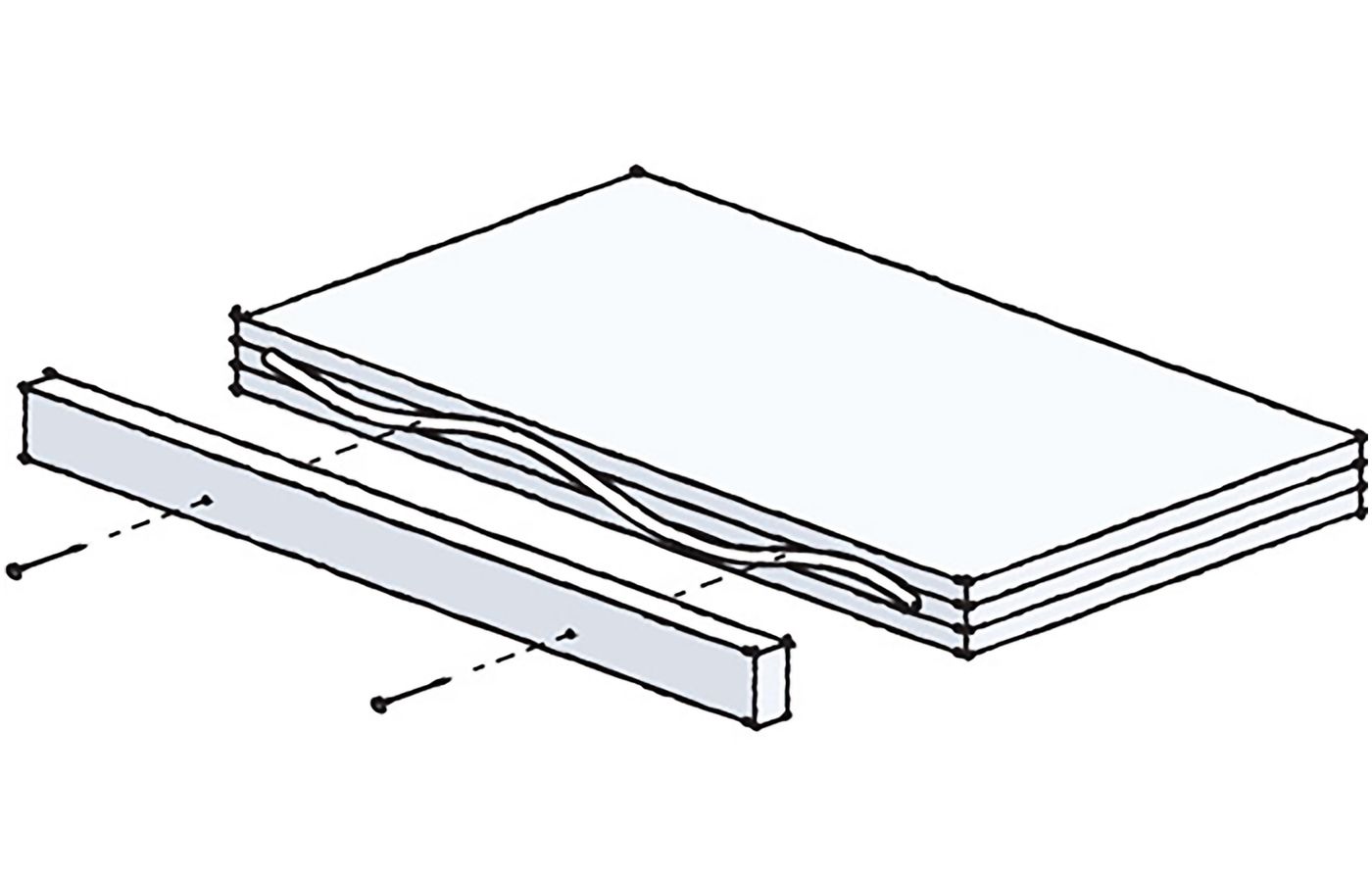
For a more professional look, wood edging involves gluing or nailing larger noses flush with the shelf top. This treatment conceals raw edges and adds visual weight to thin stock, creating the illusion of thicker shelves.
3. Molding
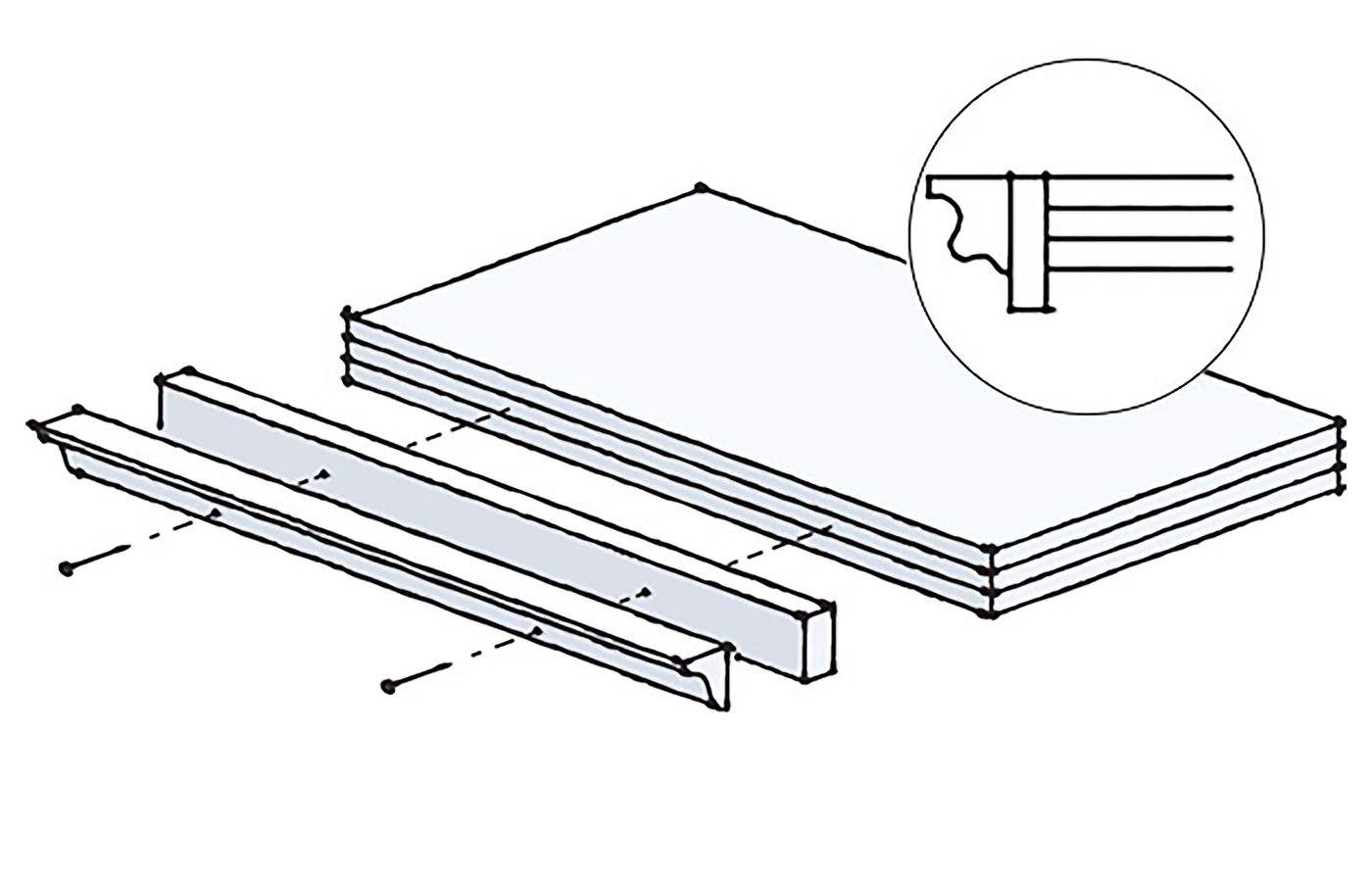
Adding a curved profile to the nosing of your shelves creates a fancier edge, elevating the overall appearance of your built-ins. Molding can range from simple quarter-round to more elaborate designs, allowing you to match the style of your room or existing trim work. However, they often come with a hefty cost.
4. Solid-Wood Face Frames
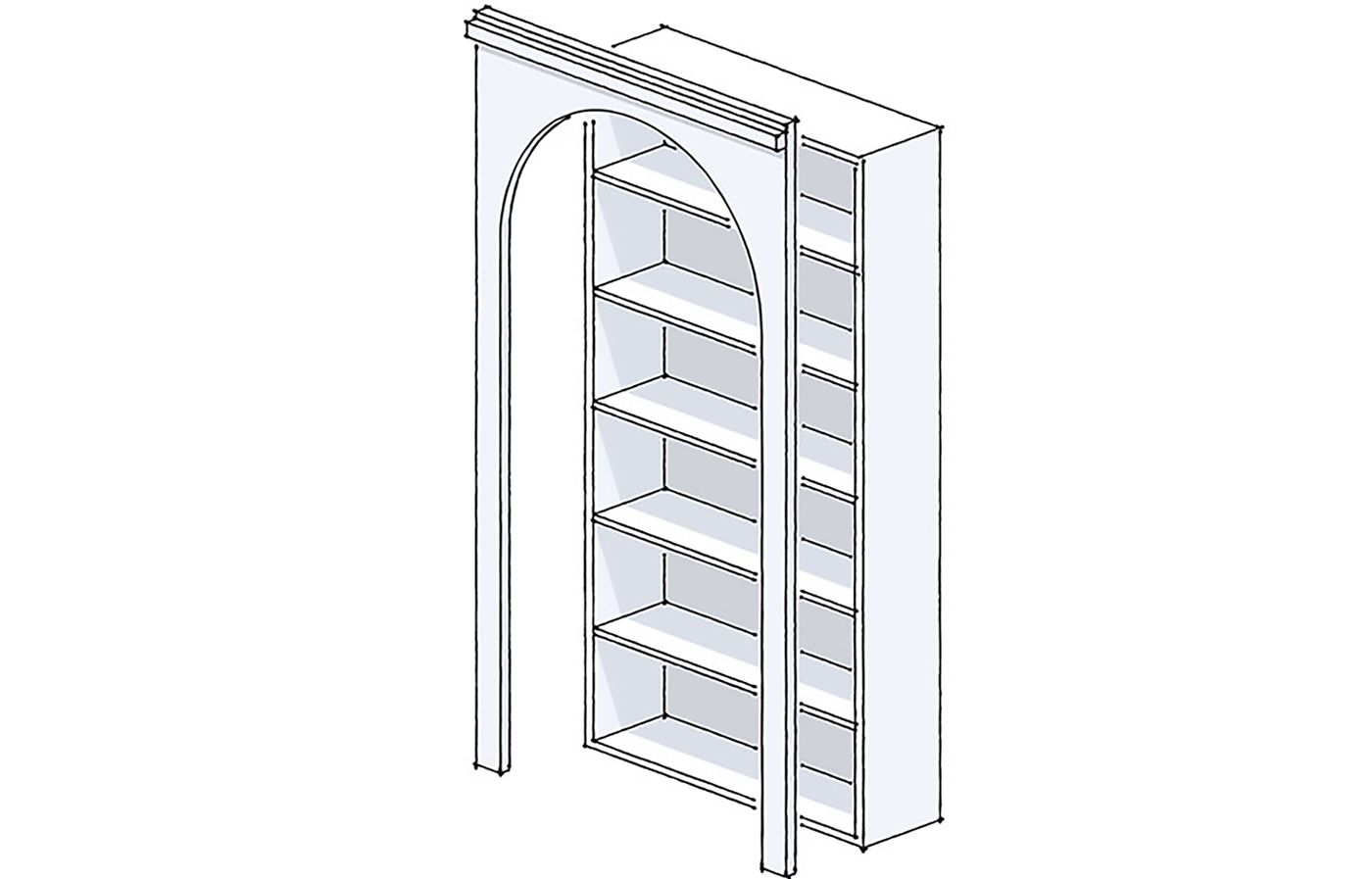
Solid-wood face frames are versatile additions that can cover joints, add visual weight, and really give your bookcase a unique look. They’re particularly useful for concealing the edges of plywood or MDF shelving and giving it a finished look that mimics solid wood construction.
Supports for Adjustable Bookshelves
Here are the options you have to hold adjustable shelves in your bookcases.
Metal Standards
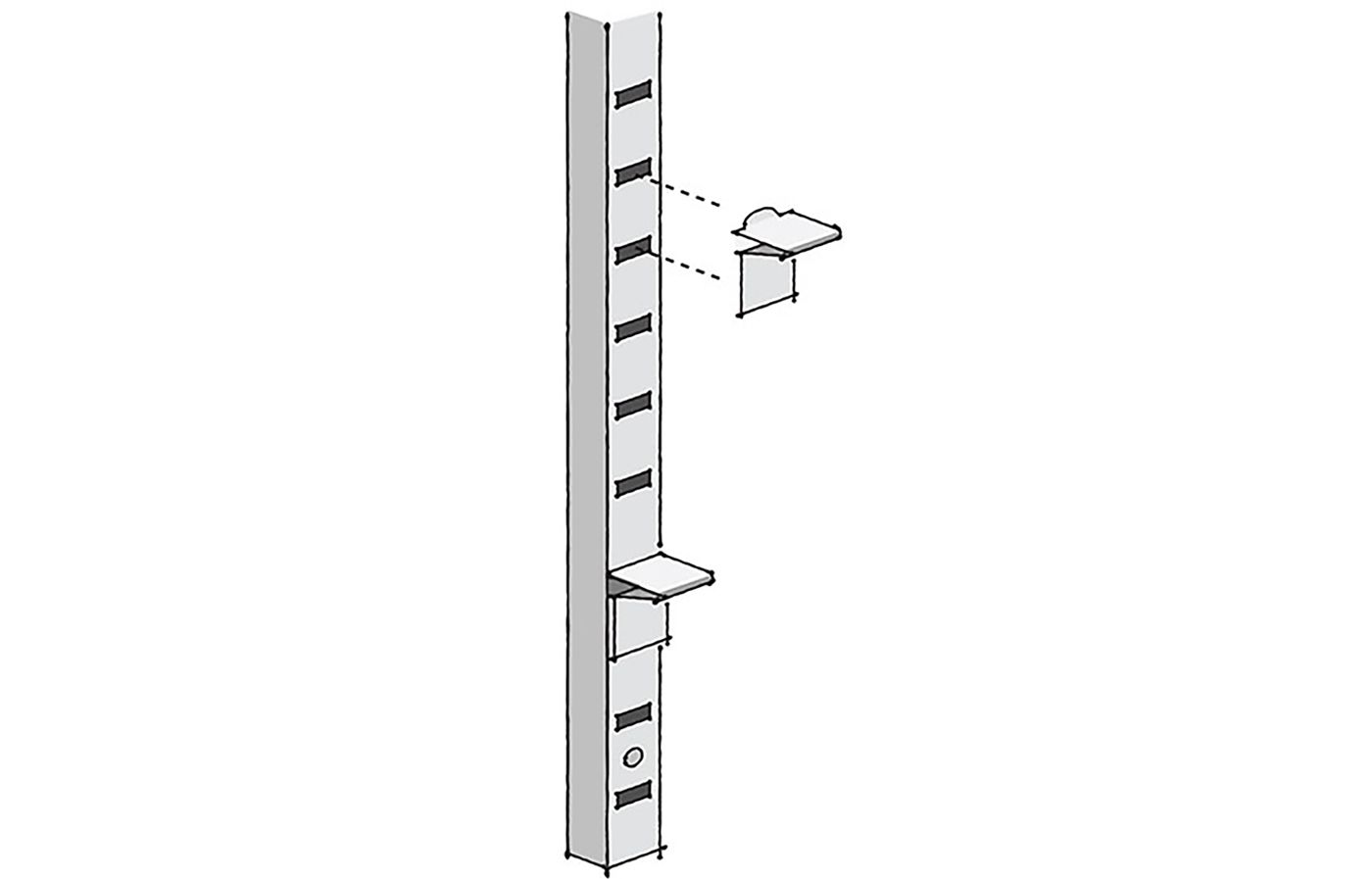
Metal standards are a popular choice for adjustable shelving because of their simplicity and strength. These vertical strips come in two widths (⅝ inch and ¼ inch) which you can recess into the side of the case for a streamlined appearance. They work together with shelf clips, allowing you to easily adjust the height.
Pins
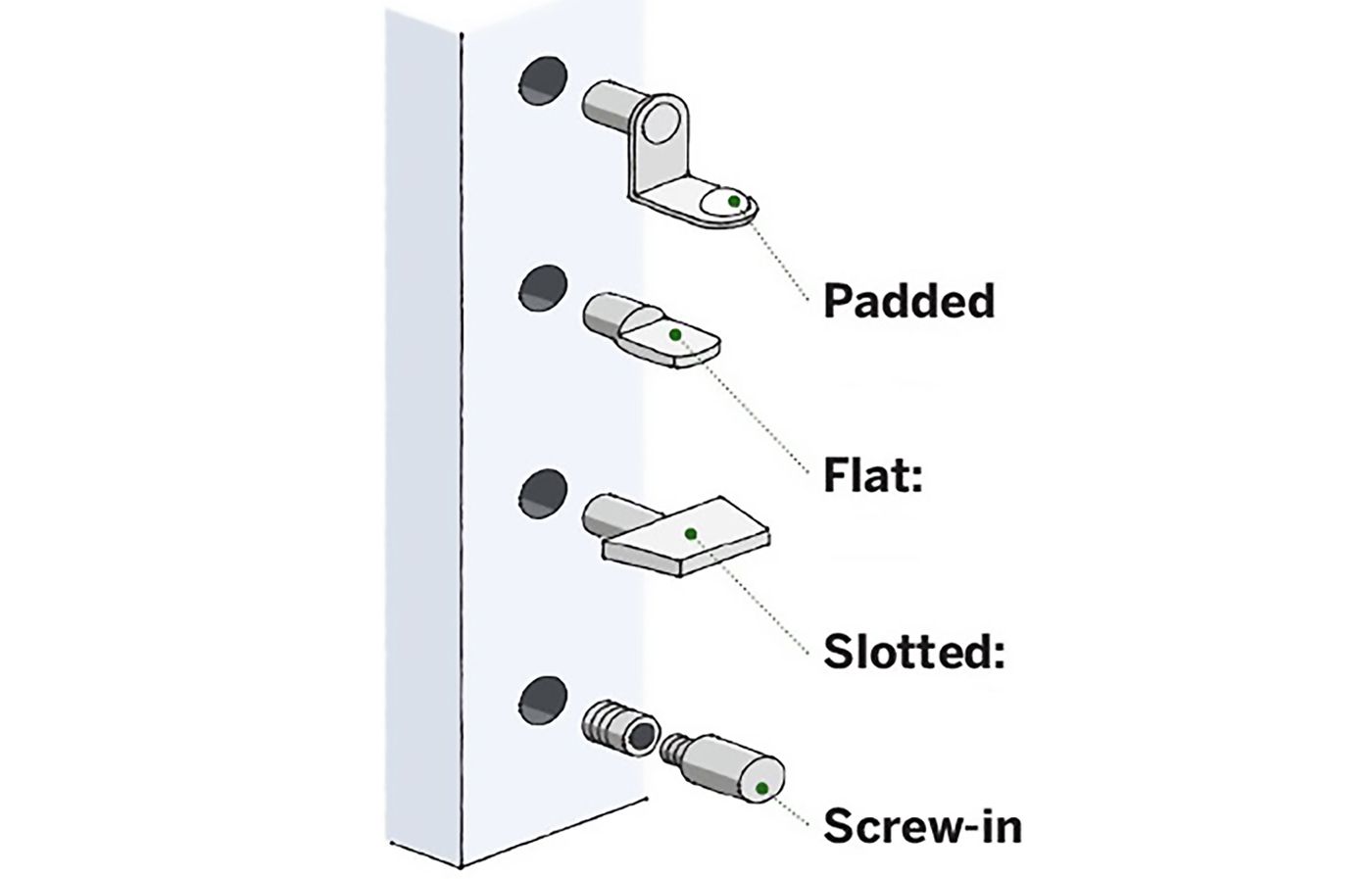
Metal pins are less obtrusive and recess into drilled holes. They offer flexibility without visible hardware. There are several types to choose from:
- Padded pins: Helps keep the shelf in place and protect it from scratches.
- Flat pins: Simple and inconspicuous, ideal for a minimalist look.
- Slotted pins: Fit into a kerf (groove) in the shelf for added stability.
- Screw-in pins: Feature a threaded sleeve for a secure hold that won’t slip out.
Supports for Fixed Shelves
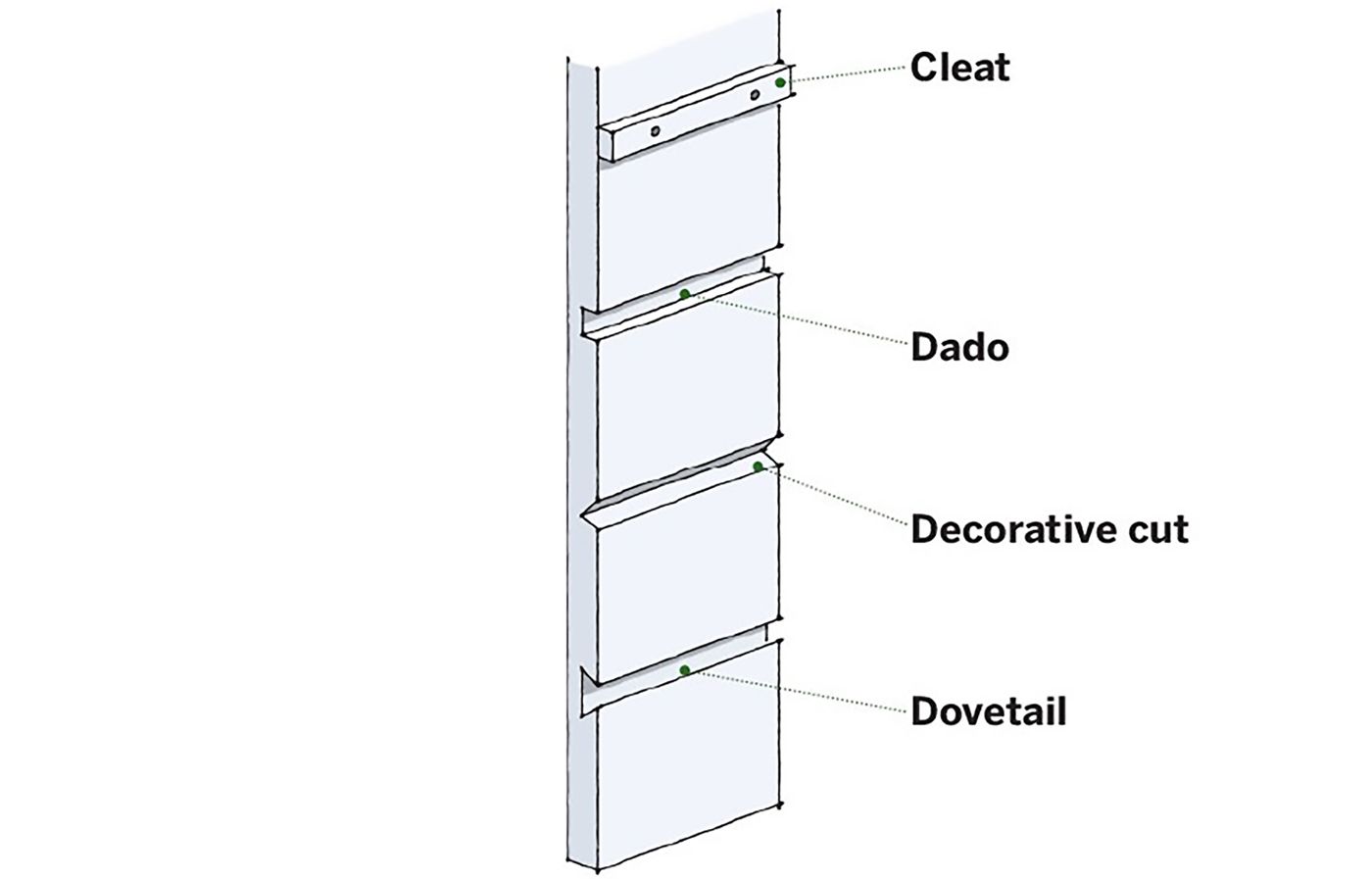
Fixed shelves offer stability and a better overall built-in look. Here are some methods for supporting fixed shelves:
- Cleat: A wood strip screwed in place that the shelf sits on top of. It’s quick and easy to install.
- Dado: The shelf slides into a groove cut into the vertical supports, providing a strong, invisible support.
- Decorative cut: Suitable for display shelves that won’t bear heavy loads, adding a decorative element.
- Dovetail: Offers a handcrafted look and strong support, typically locked in place with a hammer or woodblock.
Our Conclusion
Built-in bookcases offer a perfect blend of form and function, transforming your home while providing custom storage solutions. From library-style designs to furniture-like installations, the possibilities are endless. You can create built-ins that not only meet your storage needs but also enhance your home’s aesthetic appeal. Whether you’re a book lover, a collector, or simply in need of organized space, a well-designed built-in bookcase can be the perfect addition to your home.
